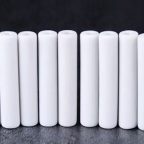Silicon carbide ceramics are non-oxide ceramic materials without any metal elements. They are composed of carbon and silicon elements. They have a particle structure similar to diamond, so they are high-strength, hardness and high-temperature corrosion-resistant ceramics. Industrial ceramics are also the most widely used ceramics among non-oxide ceramics.
Silicon carbide ceramics have different properties and different application fields due to their different preparation processes, but they are mainly used as high-temperature structural materials, refractory materials, and wear-resistant mechanical seals by using their high temperature resistance, wear resistance, corrosion resistance and other characteristics. materials, acid and alkali-resistant corrosion-resistant materials and high-temperature heat exchange materials, etc.
Silicon carbide ceramics can be divided into oxide bonding, nitride bonding, reaction bonding, liquid phase sintering, solid phase sintering and recrystallization according to the type of binder or sintering aid.Silicon carbide ceramic ring a Oxide bonded silicon carbide ceramic process and application
Mainly use silica micropowder as a binder, react with the oxide layer on the surface of silicon carbide particles to form amorphous silica, and combine the silicon carbide particles as a whole. fired. The mass fraction of silicon carbide in oxide-bonded silicon carbide ceramics is about 90%, and the flexural strength at room temperature is 50-80MPa. Since the binder is silicon dioxide, the strength begins to decline above 800 °C, and the maximum operating temperature does not exceed 1400 °C. Mainly Used as refractory material, kiln furniture material, high temperature filter material, etc.
b Process and application of nitride bonded silicon carbide ceramics
Using silicon carbide powder as the main raw material, adding a certain amount of silicon powder (generally no more than 15%), fully mixing and sintering in a nitrogen atmosphere. combined as a whole. The flexural strength of nitride bonded silicon carbide ceramics is 100-200MPa, and its strength begins to decrease at 1000 °C. Due to a small amount of silicon remaining in the product, the maximum operating temperature does not exceed 1500 °C.
c Reaction combined silicon carbide ceramic process and application
After mixing the silicon carbide powder with a certain amount of carbon powder uniformly, liquid-phase silicon infiltration (1400-1450°C) is carried out in a non-oxidizing atmosphere, so that the liquid-phase silicon reacts with the carbon in the green body to form silicon carbide, and the green body is mixed with silicon carbide. obtained by combining the silicon carbide particles as a whole. Since the reaction product is silicon carbide, and the porosity is reduced after silicon infiltration, the flexural strength of the reaction-bonded silicon carbide ceramics can reach 300-500MPa, but due to the residual silicon in the product, the strength begins to decrease at 1000 °C. Its maximum operating temperature does not exceed 1400 ℃
Black ceramic parts punching d pressureless sintered silicon carbide ceramic technology and application
Pressureless sintered silicon carbide ceramic is a dense sintered material with a relative density of up to 99% and a bending strength of 400-600MPa. The preparation method includes liquid phase sintering with alumina and yttrium oxide as sintering aids and solid phase sintering with boron and carbon as sintering aids.
The addition amount of liquid phase sintering aid is 6%-12%, and the sintering temperature is between 1800-2000 ° C; the ratio of alumina and yttrium oxide is generally controlled at 5:3, so that yttrium aluminum can be formed during the sintering process. Garnet (Y3Al5O12YAG) crystal phase to improve its high temperature performance. The addition amount of boron and carbon in solid-phase sintered silicon carbide ceramics generally does not exceed 2%, and the sintering temperature is 2150-2250 ℃, and dense sintering is achieved by solid-phase diffusion.
Due to the small amount of sintering additives and no liquid phase during the sintering process, the solid-phase sintered silicon carbide ceramics have good high-temperature performance, and their flexural strength tends to increase with the increase of temperature. When the temperature reaches 1400 ℃ It only starts to decline later, and the ceramic can be used for a long time at 1600 ℃.
e Recrystallized Silicon Carbide (RSiC) Ceramics
A high-purity silicon carbide material without any sintering aids, its purity can reach 99.5% Then it is sintered at a high temperature of 2300-2400 ℃ in an argon atmosphere.
The maximum operating temperature of RSiC in the air environment can reach 1700 ℃, and it is widely used in high temperature kiln furniture, nozzles, solar heat converters, diesel vehicle exhaust purification devices and metal smelting equipment and other products with extremely demanding material performance requirements. In addition, because recrystallized silicon carbide ceramics have good thermal conductivity and semiconductor properties, they are also used as functional materials such as heat exchange materials and ignition elements in high temperature fields.
Pintejin machining ceramic service include : Alumina Ceramic Parts, Zirconia Ceramic, Silicon Carbide Ceramic, CNC Machined Aluminum Nitride Ceramic, Machinable Ceramic Parts, Glass Ceramic,Macor Ceramic,Powder Metallurgy Dies,Ceramic Injection Molding,Ceramic Dry Pressing,Ceramic Extrusion Dies




